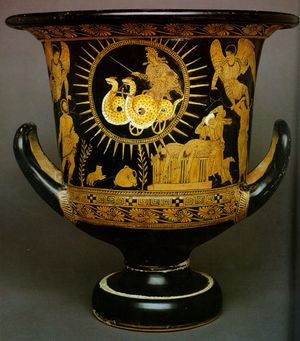Deus ex Machina
This article was initially written by Robert Woods, ASME Fellow. This article contains material published in Mechanical Engineering Magazine Mar. 2015. Copyright 2015 American Society of Mechanical Engineers
Engineers who lived two and a half millennia ago are remembered in a figure of speech we often use today - deus ex machina. The phrase (Latin for "god from a machine") refers to a device used in classical Greek and Roman theaters to resolve situations or to move a plot along. A god or supernatural messenger descends to the stage to adjust human affairs.
Typically, we moderns feel cheated because we demand logic. But ancient playwrights were not similarly constrained. And since the gods of the Greek and Roman pantheon were not troubled by human restraints like the laws of physics, they often made their appearance on stage by flying.
In ancient performances deus ex machina involved a real machina, specifically a crane. Engineers assembled an elaborate assortment of hardware to lower an actor to the stage.
The ancients were limited to a few wooden beams, ropes, and pulleys. Probably the most challenging use of this machinery occurs in the finale of the tragedy Medea. If the play was produced as written, a chariot containing three passengers would disappear in the wake of a flying dragon. That would be a big order even for today's set designers.
The ancients' willingness to invest in hardware to support elaborate theatrical productions indicates how important the theater was in community life. It was more than entertainment. The theater was a religious tradition.
Ancient theaters have been the subject of a great deal of archaeological study. This includes efforts to reconstruct the wooden deus ex machina cranes. None of the machinery has survived, so reconstruction is based on evidence in the stones of the amphitheaters.
A January 2010 article, "Deus-Ex-Machina Mechanism Reconstruction in the Theater of Phlius, Corinthia," in the ASME Journal of Mechanical Design describes the remains of a theater with features that may have supported a stage machine. The authors, Argyris Papadogiannis and Thomas G. Chondros of the University of Patras in Greece and Marilena C. Tsakoumaki of King's College London, used the evidence at the theater and in literary references to work out a very convincing reconstruction of the lifting apparatus.
The paper even contains a stress and vibration analysis of the assumed structure. Reading between the lines tells a lot about the extent to which various technologies had developed in the Aegean as early as the fourth century BCE.
Rope and pulley making which began long before in Egypt, had progressed to a point where line was obviously available in unlimited lengths and was of a quality allowing it to be bent around sheaves and winch drums. This technology, combined with a pragmatic knowledge of structures represented the ultimate state of the art at the time.
The deus ex machina is an example of technology serving culture. Just as electronic recording serves music today, structures and mechanics have served the theater. The presence of "deus ex machina" in today's vocabulary reminds us of the intimate connection that has always existed between technology and art.
